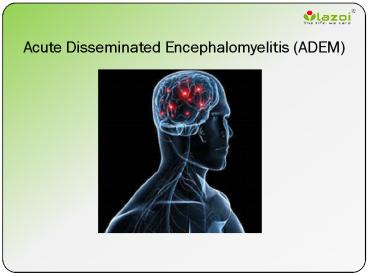Acute disseminated encephalomyelitis (ADEM): Symptoms, causes, diagnosis and treatment - PowerPoint PPT Presentation
Title:
Acute disseminated encephalomyelitis (ADEM): Symptoms, causes, diagnosis and treatment
Description:
Acute disseminated encephalomyelitis (ADEM) is a neurological, immune-mediated disorder in which widespread inflammation of the brain and spinal cord damages tissue known as white matter. – PowerPoint PPT presentation
Number of Views:1187
Title: Acute disseminated encephalomyelitis (ADEM): Symptoms, causes, diagnosis and treatment
1
Acute Disseminated Encephalomyelitis (ADEM)
2
Acute Disseminated Encephalomyelitis (ADEM)
- Acute disseminated encephalomyelitis (ADEM) is a
neurological, immune-mediated disorder in which
widespread inflammation of the brain and spinal
cord damages tissue known as white matter. White
matter is tissue composed of nerve fibres, many
of which are covered by a collection of fats and
proteins known as myelin. Myelin, which
collectively may be referred to as the myelin
sheath, protects the nerve fibres, acts as an
insulator and increases the speed of transmission
of nerve signals. Damage to the myelin sheath
affects the nerves ability to transmit
information and potentially can cause a wide
range of neurological symptoms.
3
Causes of Acute disseminated encephalomyelitis
(ADEM)
- The exact cause of ADEM is not known. However,
most clinical investigators agree that the
disorder is most likely the result of an abnormal
immune system response to an infection or other
trigger. Many researchers suggest that ADEM may
represent an abnormal immune reaction directed
against the bodys own tissues (autoimmune
disorder). In autoimmune disorders, the bodys
natural defences (e.g., antibodies, lymphocytes)
against substances that are perceived as foreign
(antigens) inappropriately begin to attack
healthy tissues, for unknown reasons.
4
Symptoms
- In some cases, a viral infection precedes the
development of symptoms by two days to four
weeks. Less often, the disorder may follow a
vaccination. However, a preceding event is not
always identified and some cases appear to occur
spontaneously. Typically, ADEM is considered a
monophasic disorder, which is a disorder that has
a single occurrence or one phase in a particular
individual. The progression and severity of
ADEM varies from one person to another. Initial
symptoms usually develop rapidly and may include
various symptoms common to many different
illnesses (nonspecific symptoms) including fever,
headaches, irritability, fatigue, lethargy, a
general feeling of ill health (malaise),
unintended weight loss and abdominal complaints
including nausea and vomiting. In some cases,
these symptoms may be followed by mental status
changes such as confusion, stupor, delirium and,
potentially, coma. The symptoms of ADEM may
also be affected by age of onset. Seizures are
common in children and adults. Long-lasting
fevers and headaches are more common in children
than adults. Sensory deficits predominantly
affect adults.
5
Diagnosis of Acute disseminated encephalomyelitis
(ADEM)
- A diagnosis of ADEM is made based upon
identification of characteristic symptoms, a
detailed patient history, a thorough clinical
evaluation and a variety of specialized tests
including imaging techniques such as magnetic
resonance imaging (MRI). An MRI uses a magnetic
field and radio waves to produce cross-sectional
images of particular organs and bodily tissues
and can demonstrate characteristic brain lesions
in individuals with ADEM. Additional tests to
exclude other conditions may also be performed.
Such tests may include infectious, immunologic,
and metabolic tests.
6
Treatments
- No standard therapy for ADEM has been
established. Most therapies that have been used
to treat ADEM have some effect of suppressing the
activity of the immune system (immunosuppressive
therapy). Such therapies include corticosteroids,
immunoglobulin (IVIg) therapy, or
plasmapheresis. High dose regimens of
corticosteroids have commonly been used to treat
individuals with ADEM and generally are
considered the mainstay of treatment.
Corticosteroids have led to an improvement of
symptoms in many cases. Corticosteroids are the
most widely reported therapy for individuals with
ADEM. Methyl prednisone is a specific
corticosteroid that is commonly used for ADEM.
7
CONNECT WITH US
- Logon to
- www.lazoi.com
- Like us on Facebook
- https//www.facebook.com/LazoiTheLife
- Follow us on Twitter
- https//www.twitter.com/lazoithelife
- Follow us on Pinterest
- https//www.in.pinterest.com/lazoithelife

